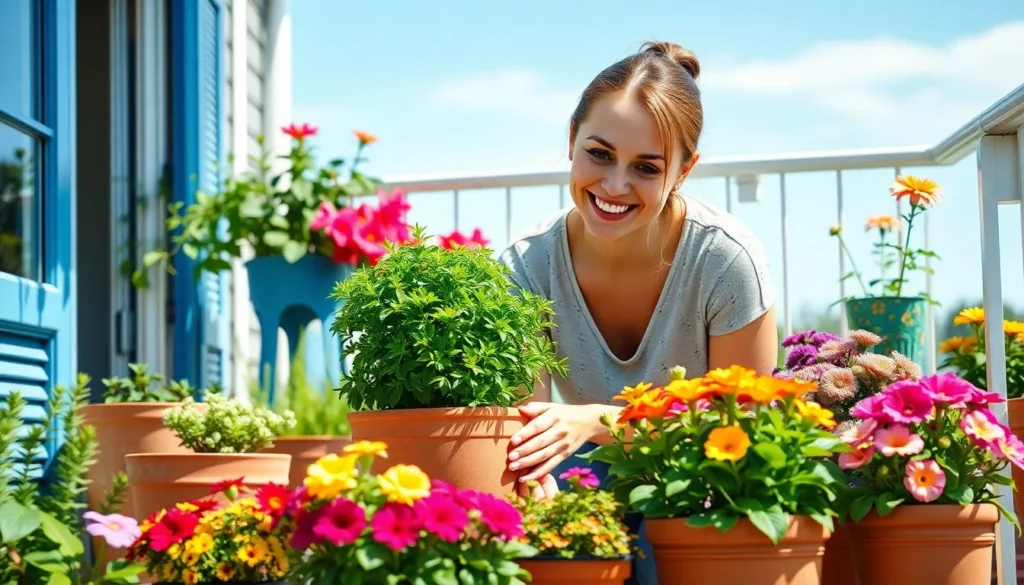Transform your outdoor space into a stunning oasis with the magic of container gardening. Whether you’re working with a sprawling backyard or a compact balcony, potted plants offer endless possibilities to create your perfect green sanctuary.
We’ve discovered that outdoor container gardening isn’t just about adding beauty to your space – it’s about flexibility and control. You can easily rearrange your garden layout, protect sensitive plants during harsh weather, and even take your favorite blooms with you if you move. Plus, potted plants give you the power to create ideal growing conditions for each plant species.
From vibrant flowering annuals that burst with color all season long to practical herbs that’ll elevate your cooking, container gardening opens doors to growing almost anything outdoors. We’ll show you how to choose the right pots, select plants that thrive in containers, and master the watering techniques that keep your garden flourishing year-round.
Choose the Right Container Size for Your Outdoor Plants in Pots
Selecting the perfect container size determines whether your outdoor plants will thrive or struggle throughout their growing season. We’ll guide you through the essential factors that influence pot size decisions for successful container gardening.
Consider Root Space Requirements
Root systems need adequate space to develop properly and support healthy plant growth. We recommend measuring the plant’s current root ball and choosing a container that’s 2-4 inches wider in diameter. Deep-rooted plants like tomatoes and peppers require containers at least 18-24 inches deep, while shallow-rooted herbs such as basil and oregano thrive in pots just 6-8 inches deep.
Small plants can become root-bound quickly in undersized containers, leading to stunted growth and poor flowering. We’ve found that most annual flowers perform best in containers between 12-16 inches wide, providing enough room for their fibrous root systems to spread. Vegetables typically need larger spaces, with leafy greens requiring minimum 8-inch depths and fruiting plants needing containers 20+ inches across.
Factor in Plant Growth Potential
Mature plant size directly impacts the container dimensions you’ll need for long-term success. We suggest researching your plant’s adult height and spread before purchasing containers, as starting with appropriately sized pots prevents frequent repotting. Dwarf varieties of popular plants like sunflowers and dahlias work better in smaller spaces, typically requiring 12-14 inch containers compared to their full-size counterparts.
Fast-growing plants such as coleus and impatiens can triple in size during a single growing season. We recommend choosing containers that accommodate this growth potential, typically selecting pots 25-50% larger than the plant’s current size. Perennial plants need even more consideration since they’ll occupy the same container for multiple years, requiring generous root space from the beginning.
| Plant Type | Minimum Container Width | Recommended Depth |
|---|---|---|
| Herbs | 6-8 inches | 6-8 inches |
| Annual Flowers | 12-16 inches | 8-12 inches |
| Vegetables (leafy) | 8-12 inches | 8-10 inches |
| Vegetables (fruiting) | 18-24 inches | 18-24 inches |
| Small Shrubs | 16-20 inches | 16-18 inches |
Account for Drainage Needs
Proper drainage prevents root rot and maintains healthy soil conditions in outdoor container gardens. We ensure every container has multiple drainage holes, typically one hole per 4-6 inches of pot diameter. Large containers over 20 inches wide need 4-6 drainage holes to prevent water from pooling in different areas of the pot.
Container depth affects drainage efficiency, with taller pots providing better water flow than shallow ones. We add 2-3 inches of drainage material like perlite or gravel to the bottom of deep containers, especially those over 16 inches tall. This layer creates space for excess water to collect without saturating the root zone, particularly important for plants sensitive to wet conditions like lavender and rosemary.
Heavy clay soils and dense potting mixes require containers with superior drainage systems. We often drill additional holes in store-bought pots and elevate containers on pot feet or bricks to improve airflow underneath. This elevation technique helps prevent water from backing up through drainage holes during heavy rainfall periods.
Select Weather-Resistant Pot Materials
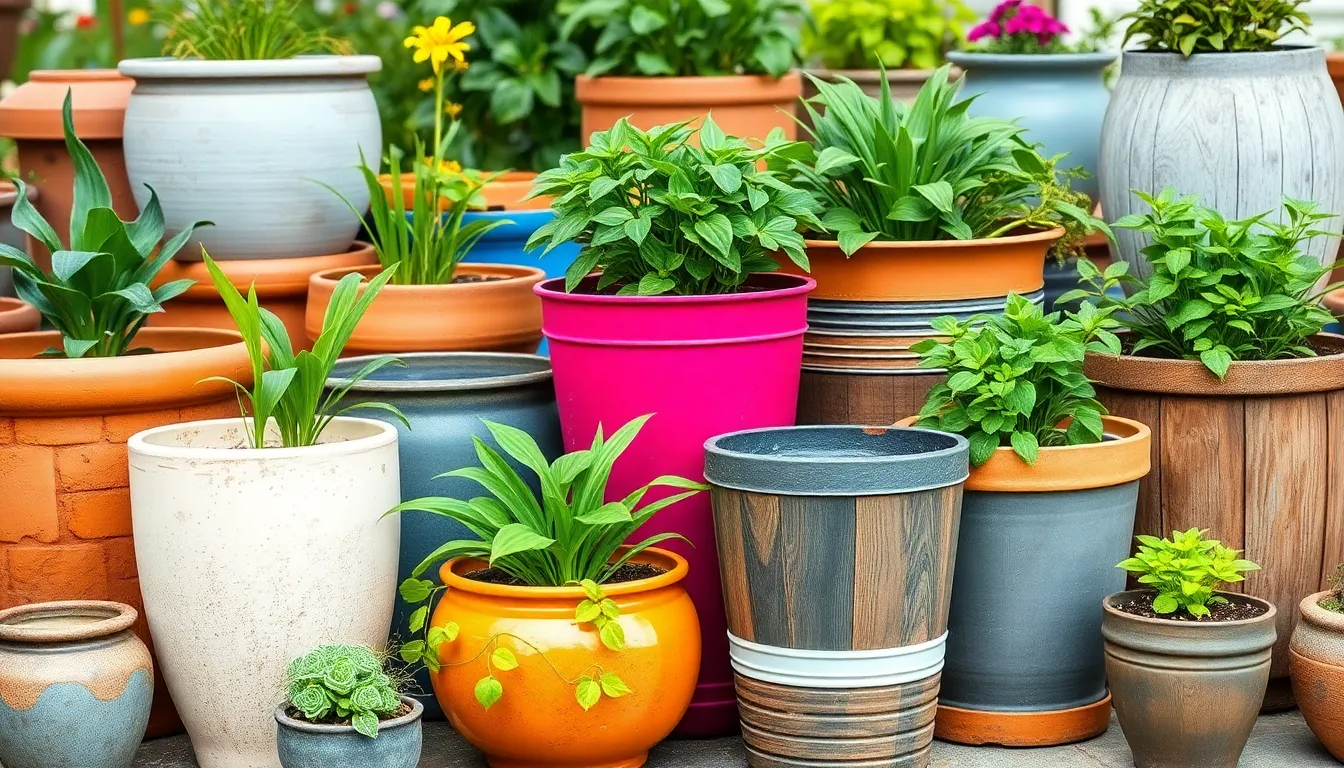
Once we’ve secured proper container sizing and drainage, choosing materials that can withstand outdoor elements becomes our next priority. Weather-resistant pot materials protect both our plants and our investment while maintaining garden aesthetics throughout changing seasons.
Evaluate Ceramic and Terra Cotta Options
Ceramic and terra cotta pots offer classic appeal with excellent breathability for plant roots. Terra cotta’s porous nature allows air circulation but absorbs water, making these containers vulnerable to cracking when temperatures freeze. We recommend glazed ceramic pots for better moisture resistance, though they still require protection during extreme weather conditions.
Breathability remains the strongest advantage of these traditional materials. Root systems thrive in terra cotta because excess moisture evaporates through the walls. But, we must consider the fragility factor when selecting ceramic options for year-round outdoor use.
Consider Plastic and Resin Alternatives
Plastic and resin containers deliver exceptional weather resistance at affordable prices. High-Density Polyethylene (HDPE) resin pots withstand temperature fluctuations without cracking while remaining lightweight and recyclable. These materials require minimal maintenance and resist impact damage that often affects other container types.
Modern resin alternatives mimic natural textures while providing superior durability. We find these containers ideal for areas with harsh winters since they won’t crack during freeze-thaw cycles. Lightweight construction makes seasonal rearrangement effortless compared to heavier materials.
Explore Metal and Wooden Containers
Metal containers like aluminum and corten steel provide contemporary aesthetics with impressive longevity. Aluminum offers rust resistance and lightweight handling, though direct sunlight can cause overheating issues for plant roots. Corten steel develops a protective rust layer that prevents further corrosion while withstanding severe outdoor conditions.
Wooden containers create natural garden integration with moderate weather resistance. Properly treated wood resists rot and moisture when maintained regularly, though it requires more upkeep than synthetic alternatives. Wood naturally insulates plant roots, keeping them cooler in summer and warmer in winter, but degrades faster under prolonged rain and sun exposure.
| Material Type | Weather Resistance | Maintenance Level | Root Insulation |
|---|---|---|---|
| HDPE Resin | Excellent | Minimal | Good |
| Aluminum | Very Good | Low | Poor |
| Corten Steel | Excellent | Very Low | Fair |
| Treated Wood | Good | High | Excellent |
| Glazed Ceramic | Fair | Medium | Good |
Pick Hardy Plant Varieties for Container Gardening
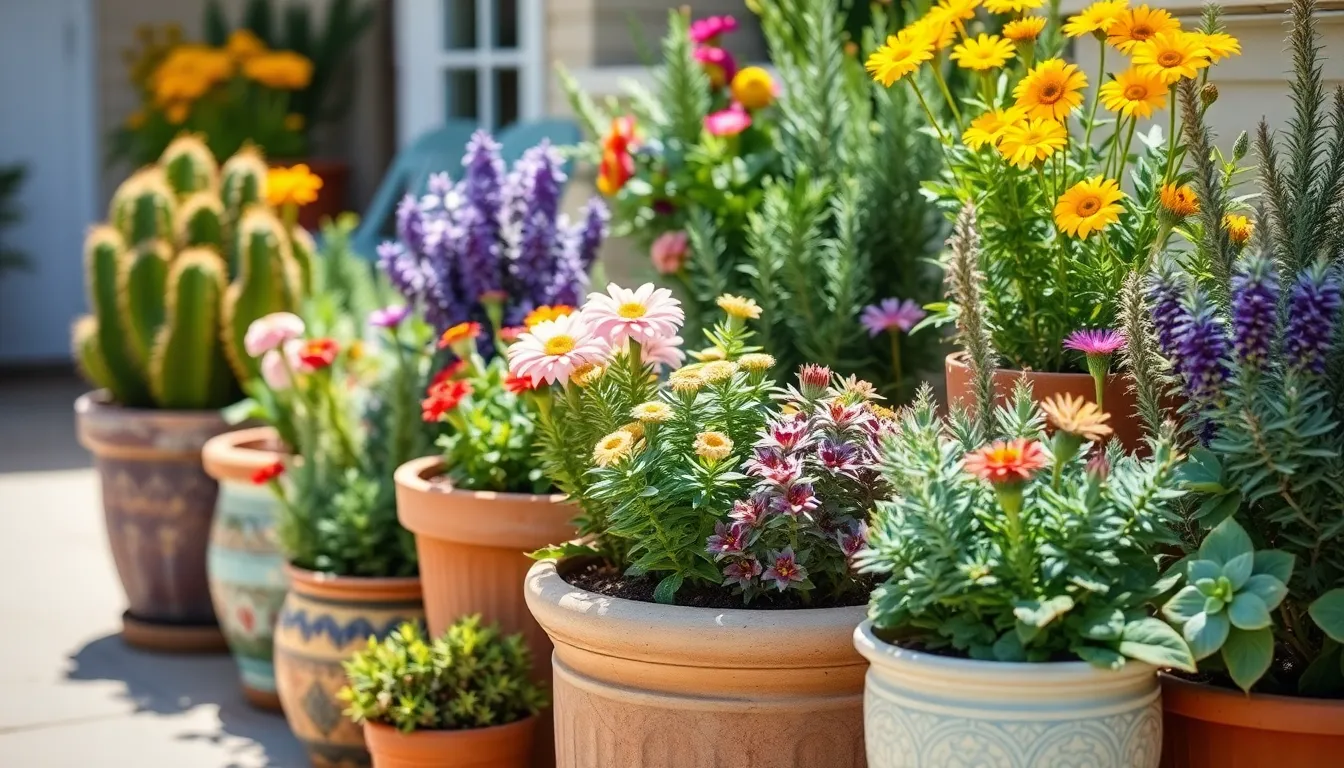
Hardy plants form the backbone of successful outdoor container gardens since they withstand fluctuating weather conditions with minimal intervention. We’ll explore three categories that deliver both resilience and beauty for your potted garden.
Opt for Drought-Tolerant Perennials
Drought-tolerant perennials thrive on neglect and excel in hot, sunny locations where other plants struggle. Cacti varieties like barrel cactus and prickly pear create striking architectural elements while requiring water only once every few weeks. Succulents such as echeveria, sedum, and jade plants store moisture in their thick leaves and bounce back quickly from dry spells.
Aloe plants offer both ornamental value and practical benefits with their healing gel while tolerating extended periods without water. Sotols develop dramatic spiky foliage that adds texture to container arrangements and flourish even in the most challenging drought conditions. These resilient perennials reduce maintenance time while ensuring your containers look lush year round.
Choose Seasonal Annuals for Color
Seasonal annuals inject vibrant colors into container gardens and can be swapped throughout the year for continuous visual interest. Trailing verbena cascades beautifully over pot edges with purple, pink, or white blooms that attract butterflies from spring through fall. Calibrochoa produces masses of small petunia like flowers in bright yellows, oranges, and reds that bloom continuously in well draining containers.
Sun coleus varieties offer bold foliage in burgundy, lime green, and copper tones that create dramatic backdrops for flowering companions. Gaillardia delivers daisy like blooms in fiery orange and red combinations that withstand heat and humidity while providing months of color. We recommend changing these annuals seasonally to maintain fresh appearances and adapt to changing weather patterns.
Select Herbs for Practical Beauty
Herbs combine culinary utility with ornamental appeal making them perfect dual purpose container plants. Rosemary develops woody stems and needle like leaves that provide year round structure while offering fragrant sprigs for cooking. Sage varieties produce silvery foliage and purple flower spikes that complement other container plants while supplying fresh leaves for seasoning.
Winter jasmine creates cascading green stems with bright yellow blooms that brighten containers during cooler months when most plants go dormant. Fuchsia plants dangle elegant bell shaped flowers in pink, purple, and white combinations that hummingbirds adore throughout the growing season. These herb and flowering plant combinations ensure your containers serve multiple purposes while requiring only basic care routines.
Prepare Proper Drainage Systems
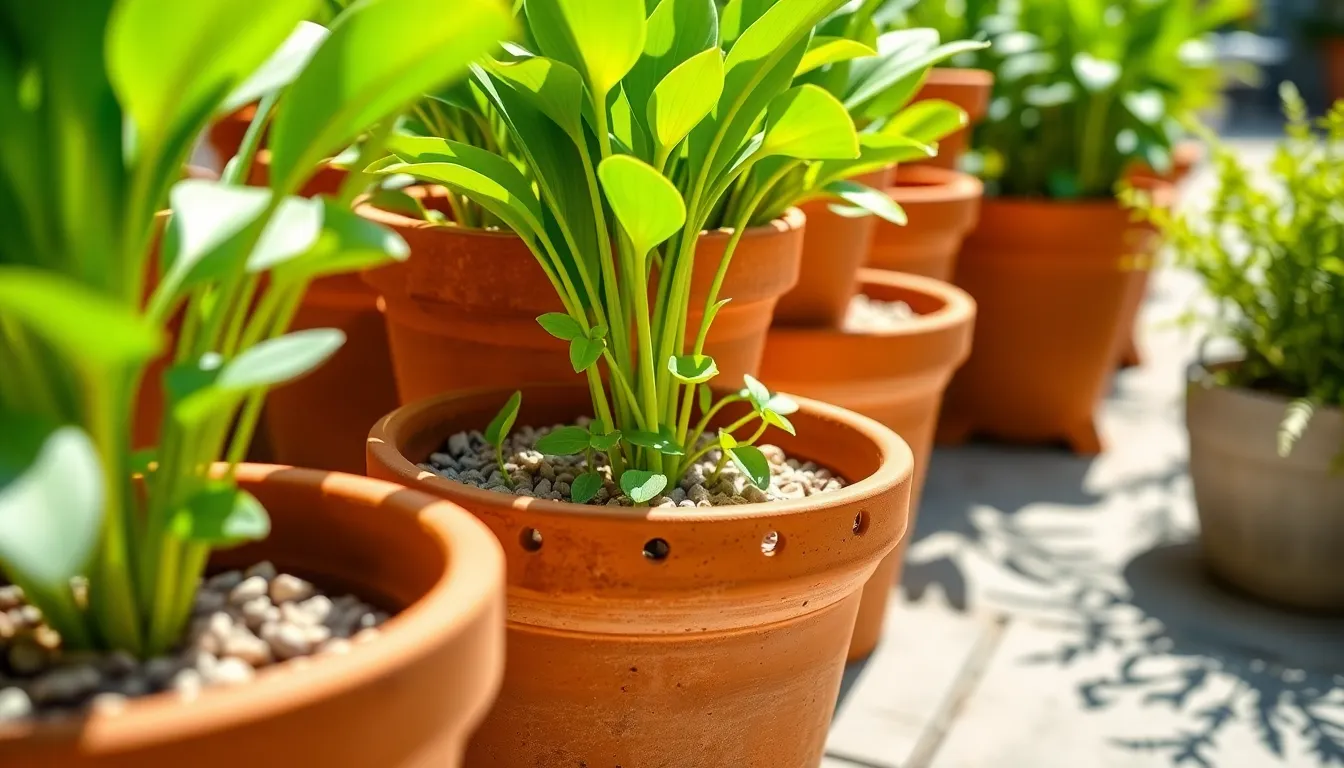
Proper drainage prevents waterlogging that can cause root rot by depriving roots of essential oxygen. We’ll establish healthy root environments and promote better plant growth through effective drainage strategies.
Install Drainage Holes
Drainage holes at the bottom of pots allow excess water to escape freely while ensuring adequate air reaches the roots. We always use containers with multiple drainage holes to prevent stagnant water buildup that can harm plant health.
Small holes typically suffice for most containers and prevent excessive soil loss during watering. Drilling holes becomes necessary when using decorative pots that lack proper drainage openings.
Careful water management requires manual draining of excess water when using pots without holes. We recommend this approach only as a temporary solution since it increases maintenance requirements.
Add Gravel or Pottery Shards
Gravel layers at the bottom of containers expedite drainage by allowing water to flow away from soil quickly. We create this drainage foundation using clean gravel or broken pottery shards before adding potting mix.
Double potting setups work best with gravel placement inside larger decorative containers. We position the inner pot with drainage holes above the gravel layer to maximize water flow efficiency.
Pottery shards provide excellent drainage while recycling broken ceramic materials from old containers. We layer these materials to create air pockets that enhance root aeration and prevent soil compaction.
Use Quality Potting Mix
High quality potting mixes designed specifically for container gardening outperform regular garden soil in outdoor pots. We select mixes containing organic matter such as compost or coconut coir that improve moisture retention while allowing excess water to drain.
Sandy soil incorporation or coarse sand addition breaks up dense soil clumps and enhances water flow throughout the container. We blend these materials into potting mix to create optimal growing conditions for root development.
Coconut coir and compost combinations provide balanced moisture management that prevents both drought stress and waterlogged conditions. We choose potting mixes with these components to support healthy plant growth in varying weather conditions.
Position Your Outdoor Plants in Pots Strategically
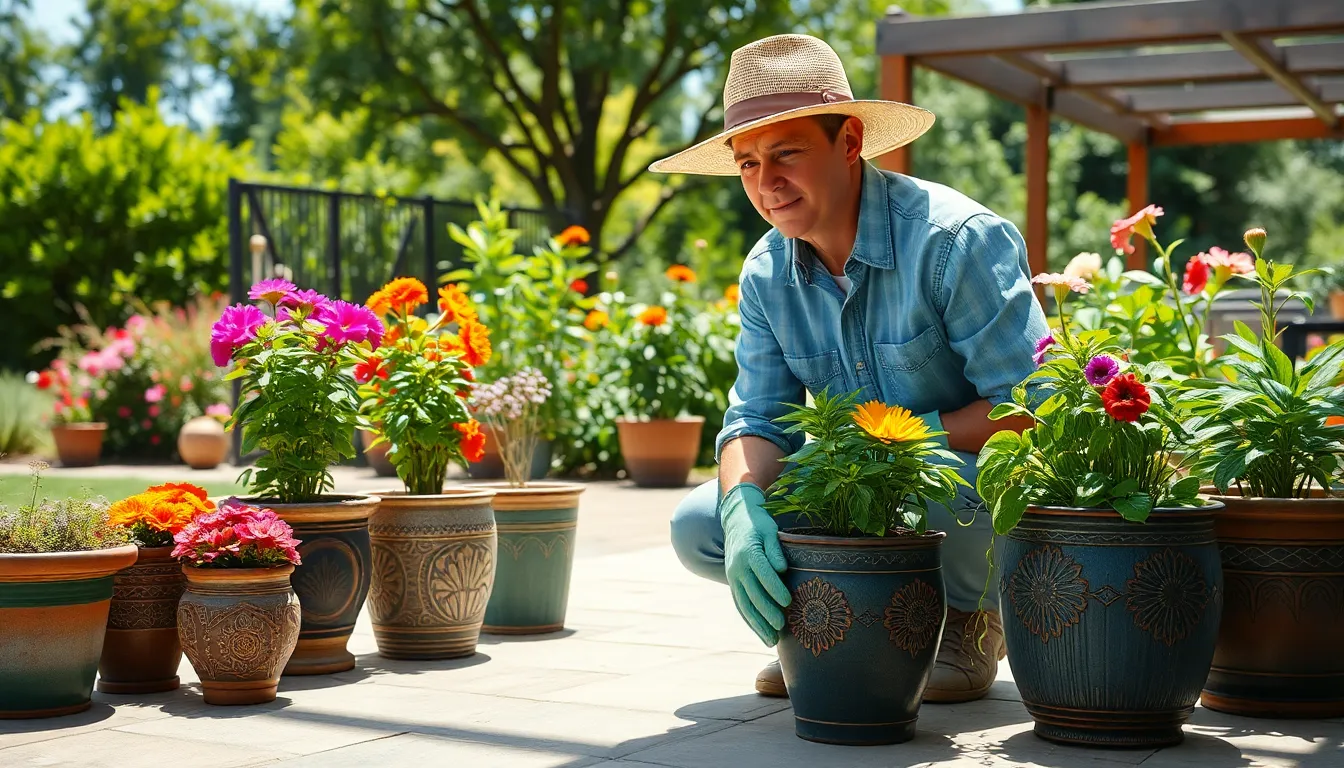
Strategic placement of outdoor plants in pots transforms how effectively they grow and thrive throughout the seasons. We’ll optimize plant health by considering environmental factors that directly impact their success.
Assess Sunlight Requirements
Different plants thrive with varying levels of sunlight exposure, making proper assessment crucial for container gardening success. We need to identify each plant’s exact light preferences before positioning pots around our outdoor spaces. Plants like petunias require full sun exposure and demonstrate excellent heat tolerance, while pansies perform better with cooler morning sunlight or partial shade conditions.
Container plants dry out faster than their in-ground counterparts due to increased environmental exposure from all sides. We must match sunlight requirements with appropriate watering schedules to maintain optimal growing conditions. Plants receiving full sun exposure will need more frequent watering than those positioned in partially shaded areas.
Consider Wind Protection
Wind exposure rapidly dehydrates container plants and can damage delicate foliage throughout the growing season. We should position pots in naturally sheltered locations or create windbreaks using fencing, screens, or larger plants as barriers. Strong gusts increase water loss dramatically and create stress conditions that weaken plant health over time.
Protected positioning reduces watering frequency and helps maintain consistent soil moisture levels. We can use nearby structures like walls, pergolas, or garden sheds as natural wind barriers for our container plants.
Plan for Easy Maintenance Access
Container plants require frequent attention since their soil dries quickly and nutrients deplete faster than traditional garden beds. We need to position pots where daily soil moisture checks, watering, fertilizing, and pruning tasks remain easily accessible. Strategic placement near water sources reduces the effort required for regular maintenance routines.
Proper access planning ensures we can monitor plant health effectively and respond quickly to changing conditions. We should arrange containers so that all plants receive equal attention without creating obstacles that discourage regular care.
Establish Consistent Watering Routines
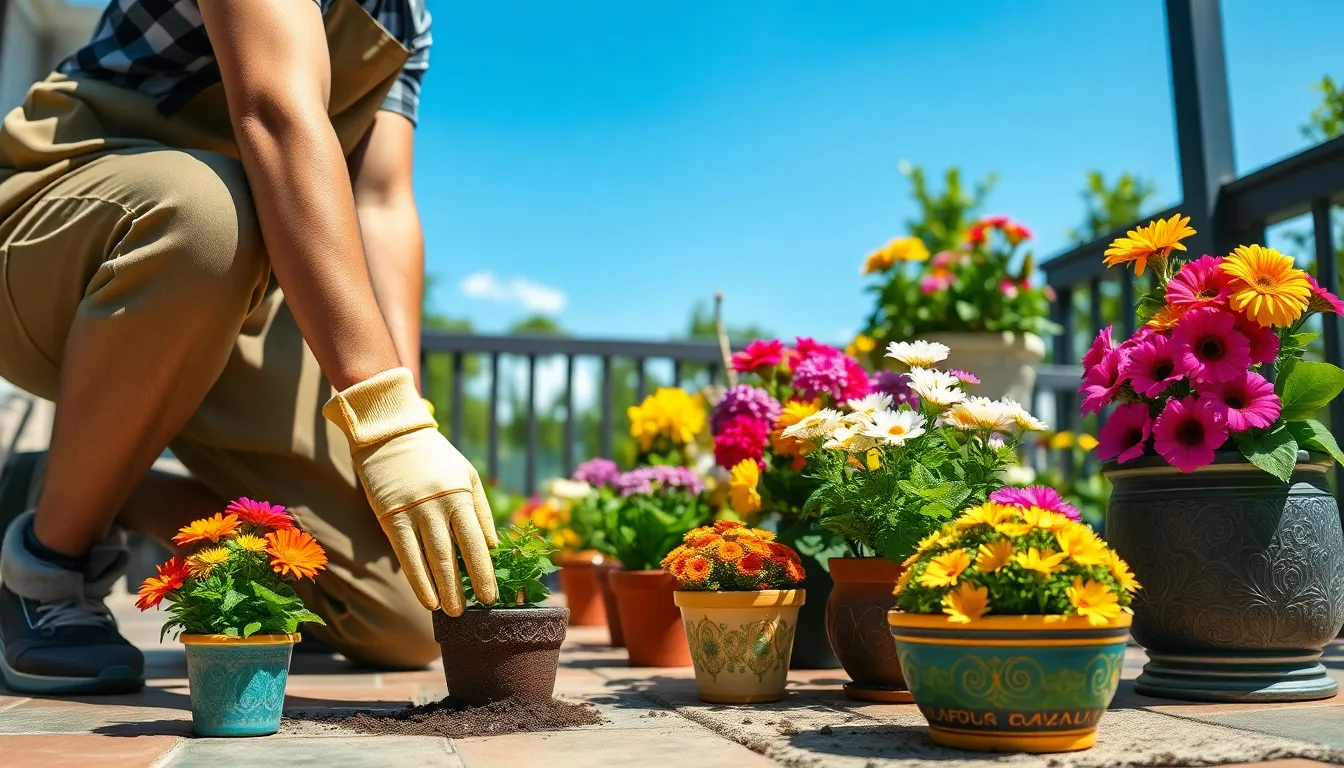
Creating a reliable watering schedule forms the foundation of successful container gardening. We’ll guide you through monitoring soil conditions, adapting to seasonal needs, and implementing efficient irrigation systems.
Monitor Soil Moisture Levels
Checking soil moisture regularly prevents both overwatering and underwatering disasters. We recommend feeling the soil surface with your finger to determine when plants need water. Quality potting soil designed for containers retains moisture and nutrients better than regular garden soil, making moisture management more predictable.
Using moisture meters provides precise readings for gardeners who prefer exact measurements. These tools help us avoid the most common container gardening mistake: overwatering. Soil should feel moist but never waterlogged, as soggy conditions lead to root rot and plant death.
Different plants require varying moisture levels throughout their growing cycles. Petunias thrive with watering every 5-7 days, while impatiens need frequent watering to maintain consistent moisture without becoming soggy. We adjust our monitoring frequency based on each plant’s exact requirements.
Adjust for Seasonal Changes
Container plants demand more attention during warmer months when evaporation rates increase dramatically. We water more frequently and provide additional feeding during hot weather, sometimes requiring daily watering sessions. During hot spells, soil in containers dries out much faster than ground plantings.
Winter care requires a completely different approach to moisture management. We reduce watering frequency significantly when plants enter dormancy periods. Cold weather slows plant metabolism, meaning less water absorption and slower soil drying.
Protecting containers from winter weather prevents soil from becoming waterlogged during freeze thaw cycles. We use biodegradable fleece covers or move pots under protective structures during harsh conditions. Feeding schedules also change, with most plants requiring no nutrients during winter months except certain annuals that benefit from feeding until early autumn.
Install Drip Irrigation Systems
Drip irrigation delivers water slowly and directly to soil surfaces, eliminating waste and reducing leaf wetness. We install these systems to maintain consistent moisture levels without manual daily watering. Automated drip systems prove especially valuable during vacation periods or extended hot weather.
These systems prevent common watering mistakes by delivering precise amounts of water at scheduled intervals. We position drip emitters to target root zones directly, ensuring deep soil penetration without surface runoff. Water reaches plant roots efficiently while keeping foliage dry, reducing disease risks.
Setting up programmable timers allows us to customize watering schedules for different plant groups. Morning watering times work best, giving plants time to absorb moisture before evening temperatures drop. We avoid late day watering sessions that leave plants wet overnight, creating ideal conditions for fungal diseases.
Fertilize Container Plants Regularly
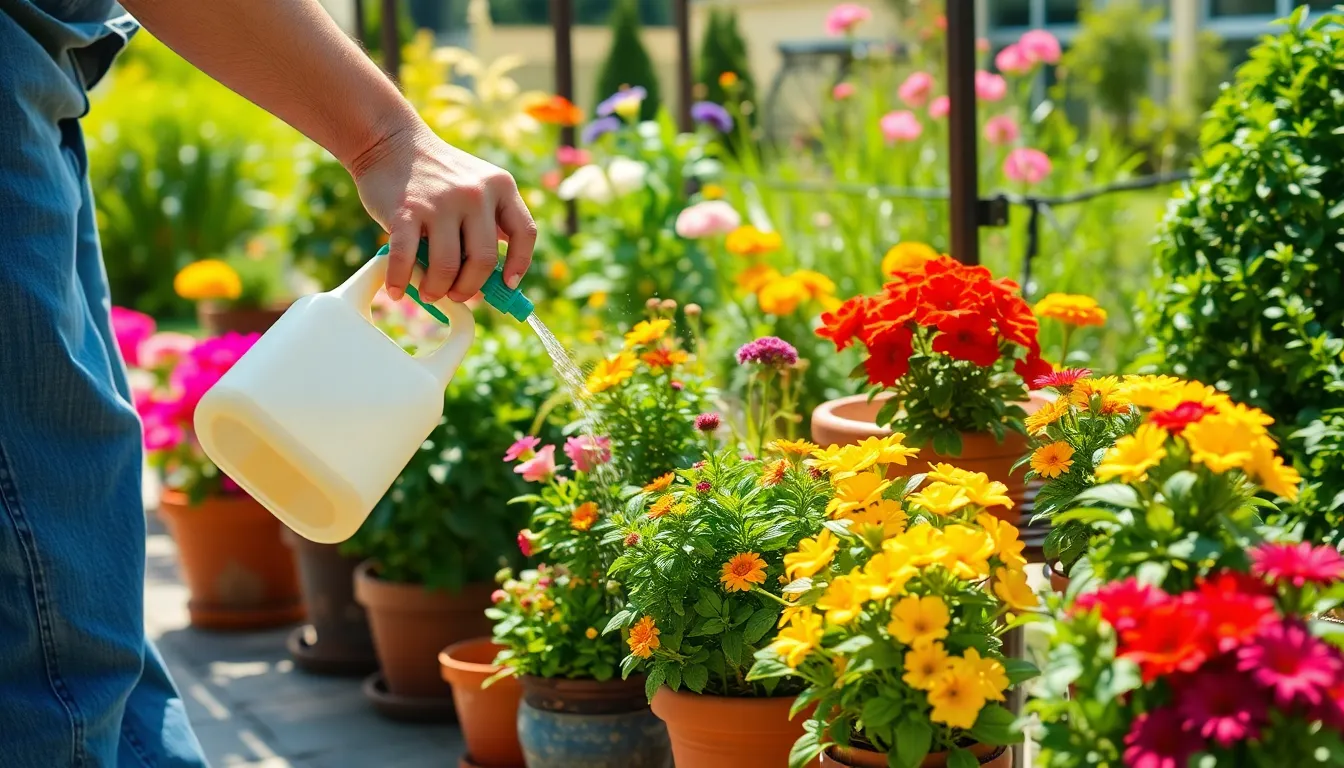
Container plants need consistent nutrition since they can’t access nutrients beyond their limited soil environment. We should begin feeding our outdoor potted plants about three weeks after planting, once any built-in fertilizer has been depleted.
Choose Appropriate Fertilizer Types
Water-soluble fertilizers offer the quickest nutrient absorption for our container plants. These fertilizers dissolve easily in water and should be applied every 2-3 weeks during the growing season. Alternatively, we can use them weekly at half strength to maintain steady nutrient levels.
Slow-release fertilizers provide consistent feeding for up to three months with each application. These granular options release nutrients gradually with each watering, making them ideal for larger pots or container trees and shrubs. They’re perfect when we want to reduce feeding frequency while maintaining plant health.
Dry granular fertilizers work well when sprinkled on the soil surface and watered in thoroughly. But, we must ensure these fertilizers are specifically formulated for container use to avoid over-concentration in the limited soil space.
Follow Seasonal Feeding Schedules
Spring through late summer represents the prime fertilization period for our outdoor container plants. During these months of active growth, we should maintain regular feeding schedules based on our chosen fertilizer type. Water-soluble options require applications every 2-3 weeks, while slow-release fertilizers need fewer applications throughout the season.
Winter months call for reduced or paused fertilization as plant growth naturally slows. Some gardeners prefer adding weak doses of liquid fertilizer with each watering to maintain consistent nutrient availability during peak growing periods.
Monitor Plant Health Indicators
Yellowing leaves often signal the first signs of nutrient deficiency in our container plants. When we notice this symptom, it’s time to adjust our fertilization schedule or switch to a different fertilizer type. Stunted growth and poor flowering also indicate that our plants aren’t receiving adequate nutrition.
Consistent observation helps us identify these issues before they become severe problems. By watching for changes in leaf color, growth patterns, and flowering performance, we can fine-tune our feeding approach to maintain vibrant, productive container gardens throughout the growing season.
Protect Plants from Extreme Weather

Outdoor potted plants face unique challenges from extreme weather conditions that can quickly damage or kill our carefully cultivated gardens. We need proactive strategies to shield our containers from nature’s harsh elements while maintaining healthy growing conditions year-round.
Prepare for Winter Conditions
Cold snaps and freezing temperatures pose serious threats to our container plants since roots in pots are more exposed than those in the ground. We should move sensitive plants indoors or relocate them to protected areas like garages, covered patios, or greenhouse structures before temperatures drop below their tolerance levels.
Proper drainage becomes even more critical during winter months as waterlogged soil can freeze and damage root systems. We can apply mulch to the soil surface inside containers to insulate roots from temperature fluctuations while providing an extra layer of protection.
Sheltered locations reduce exposure to harsh winter winds and frost that can desiccate plant tissues. We need to position our containers against south-facing walls or in areas that receive maximum winter sunlight to help plants maintain their energy reserves during dormant periods.
Shield from Summer Heat Stress
Heatwaves create intense stress for potted plants as containers heat up faster than ground soil and dry out more quickly. We should relocate our containers to shaded areas or position them against north-facing walls during extreme heat events to reduce direct sun exposure.
Shade cloth provides excellent protection when natural shade isn’t available, with 30% to 50% shade cloth being most effective for most plants. We need to support the cloth properly so it doesn’t touch plant foliage while still providing adequate coverage.
Mulching the soil surface inside pots and around container bases helps keep root zones cooler during temperature spikes. We must increase watering frequency during heat stress but avoid applying insecticides since stressed plants become more susceptible to chemical damage.
Water requirements increase significantly during summer heat as container soil dries out much faster than garden beds. We should check soil moisture daily and water early morning or late evening to minimize evaporation and heat stress on plants.
Secure Containers During Storms
Heavy storms with strong winds, hail, and torrential rain can quickly destroy our container gardens if we don’t take protective measures. We need to move pots indoors or to sheltered locations like garages or covered patios whenever severe weather threatens our area.
Large or heavy containers that can’t be moved require alternative securing methods to prevent tipping and breakage. We can position these containers against sturdy walls, add weights like bricks around the base, or use stakes to anchor them in place during storm events.
Pruning weak or overgrown branches before storm season reduces the risk of breakage and makes plants more aerodynamic in high winds. We should remove any dead, diseased, or structurally compromised growth that could become projectiles during severe weather.
Drainage becomes critical during heavy rainfall as waterlogged containers can lead to root rot and plant death. We must ensure all drainage holes remain clear and consider elevating pots slightly to help water runoff and prevent standing water around container bases.
Staking tall or top-heavy plants provides additional stability during windy conditions and prevents containers from becoming unbalanced. We can use bamboo stakes or metal supports tied securely to plant stems without restricting natural movement or growth.
Maintain and Refresh Your Container Garden
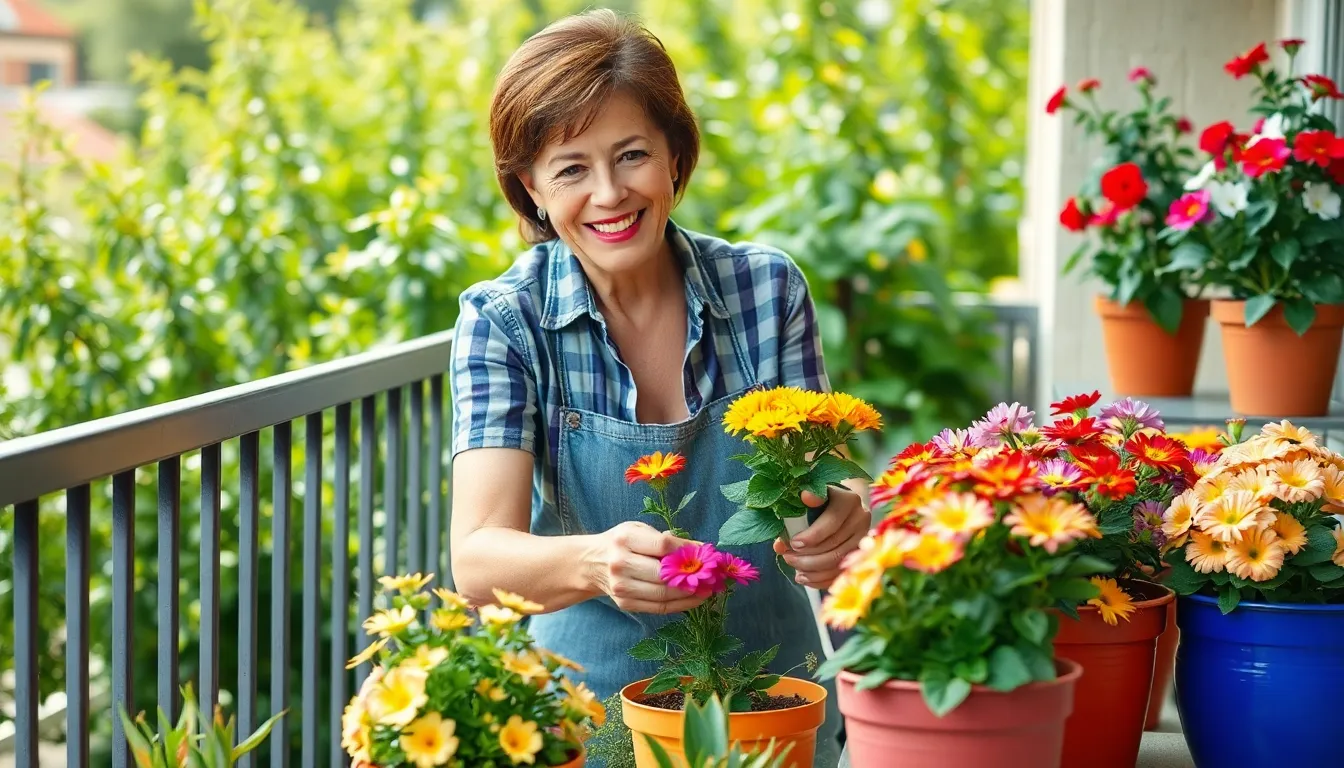
Ongoing maintenance keeps our container gardens healthy and thriving throughout the growing season. We’ll focus on three essential practices that ensure optimal plant performance year after year.
Prune and Deadhead Regularly
Pruning dying or damaged leaves helps encourage healthy new growth while maintaining plant vigor. We should inspect our container plants weekly for yellowing foliage, broken stems, or wilted portions that drain energy from healthy plant parts.
Deadheading spent flowers extends blooming periods significantly throughout the growing season. Remove faded blooms by pinching or cutting just above the next leaf node or flower bud to stimulate continuous flowering.
Trimming leggy or non-blooming stems maintains attractive plant shape and promotes bushier growth. Cut back overgrown stems by one-third to encourage branching and prevent plants from becoming sparse or top-heavy in their containers.
Replace Soil Annually
Fresh potting soil prevents nutrient depletion that naturally occurs in container environments. We must replace the entire soil volume each year because limited container space causes nutrients to become exhausted faster than in ground plantings.
Soil compaction reduces drainage and aeration essential for healthy root development. Old potting mix becomes dense over time, restricting water movement and oxygen flow that roots need for optimal growth.
New soil ensures good drainage properties that prevent waterlogging and root rot issues. Quality potting mixes contain ingredients like perlite and vermiculite that maintain proper moisture balance throughout the growing season.
Rotate Plant Arrangements
Rotating plants between different containers helps manage soil nutrient depletion more effectively. We can move heavy feeders like tomatoes to fresh soil locations while placing lighter feeders in previously used containers.
Changing plant positions optimizes light exposure for species with varying sun requirements. Move shade-loving plants to more protected locations during intense summer heat, while relocating sun lovers to brighter spots as seasons change.
Swapping plant locations reduces pest pressures and disease risks that build up in exact areas. Different plant species attract different pests, so rotation breaks pest cycles and prevents concentrated infestations from developing in our container gardens.
Conclusion
Container gardening opens endless possibilities for transforming any outdoor space into a thriving green sanctuary. We’ve covered the essential foundations that’ll set you up for success: choosing properly sized containers with excellent drainage weatherproof materials and hardy plant varieties that suit your climate.
The key lies in understanding your plants’ exact needs and creating optimal growing conditions through strategic placement consistent watering schedules and regular fertilization. By implementing proper maintenance routines and weather protection strategies you’ll enjoy beautiful healthy plants year-round.
Whether you’re working with a sprawling patio or a compact balcony these container gardening principles will help you create the outdoor oasis you’ve always envisioned. Start small experiment with different combinations and watch your confidence grow alongside your thriving potted garden.
Frequently Asked Questions
What size container should I choose for my outdoor plants?
Choose containers that are 2-4 inches wider than your plant’s root ball. Different plants need varying depths: shallow-rooted plants like lettuce need 6-8 inches, while deep-rooted vegetables require 12+ inches. Always consider your plant’s mature size to avoid frequent repotting and ensure healthy growth.
Which pot materials are best for outdoor container gardening?
Weather-resistant materials include plastic and resin for excellent durability and lightweight handling, metal containers like aluminum for contemporary looks, and ceramic or terra cotta for breathability. Wooden containers offer natural aesthetics but require more maintenance. Choose based on your climate and aesthetic preferences.
What are the best plants for container gardening?
Hardy options include drought-tolerant perennials like cacti and succulents, which require minimal water. Seasonal annuals like trailing verbena and calibrochoa provide vibrant colors. Herbs like rosemary and sage offer both culinary benefits and ornamental appeal while being relatively low-maintenance.
How do I ensure proper drainage in my containers?
Install multiple drainage holes in your pots to prevent waterlogging. Add a layer of gravel or pottery shards at the bottom for enhanced drainage and aeration. Use quality potting mixes designed for containers, and avoid using regular garden soil which can retain too much moisture.
Where should I place my potted plants outdoors?
Position plants based on their sunlight requirements – full sun, partial shade, or full shade. Place containers in sheltered locations to protect from strong winds, or use barriers for wind protection. Ensure easy access for maintenance tasks like watering, pruning, and monitoring plant health.
How often should I water my container plants?
Check soil moisture regularly using your finger or a moisture meter. Container plants typically need more frequent watering than ground plants since they dry out faster. Adjust frequency based on season, weather, and plant type. Consider drip irrigation systems for consistent, efficient watering.
How often should I fertilize container plants?
Begin fertilizing three weeks after planting. Use water-soluble fertilizers every 2-3 weeks or slow-release fertilizers every 2-3 months. Monitor plants for signs like yellowing leaves or stunted growth, which indicate nutrient deficiencies. Container plants need regular feeding since nutrients wash away with frequent watering.
How can I protect my container plants from extreme weather?
In winter, move sensitive plants indoors or to sheltered areas, apply mulch for insulation, and position away from cold winds. During summer heat, relocate to shade, use shade cloth, and increase watering frequency. Secure containers during storms and ensure proper drainage to prevent damage.
What ongoing maintenance do container plants need?
Regularly prune and deadhead plants to encourage new growth and extended blooming. Replace potting soil annually to prevent nutrient depletion and compaction. Rotate plant arrangements to optimize light exposure and reduce pest pressure. Monitor for pests and diseases, addressing issues promptly to maintain plant health.

